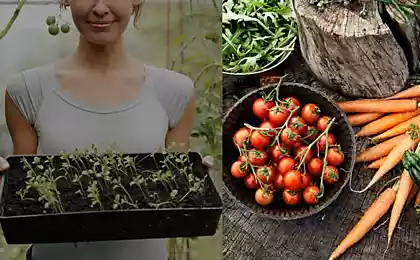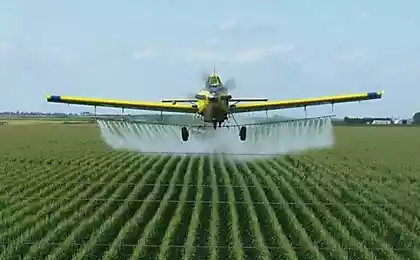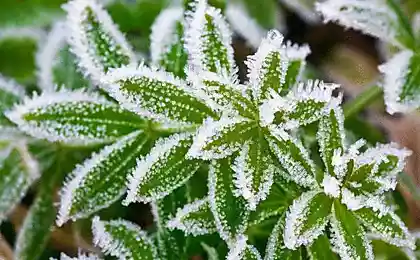542
Biological method of plant protection
Interview with candidate of biological Sciences, head of the laboratory of microbiological methods of plant protection from pests and diseases of the RUE "Institute of plant protection" Dmitry Wojtek.
Organic farming every year more and more gaining momentum. Many are trying to grow your own organic vegetables and fruit. There is an active search for safe and alternative chemical methods of plant protection from diseases and pests. And I must say, such methods are already there. One of them is biological. About it we'll talk today with the head of the laboratory of microbiological methods of plant protection from pests and diseases of the RUE "Institute of plant protection", candidate of biological Sciences Dmitry Wojtek.
— Dmitry Vladimirovich, before we start talking about useful, let's focus on the dangers posed by pesticides.
— The use of chemicals (often inept and in large quantities) against pests, diseases and weeds leads to the fact that pesticides accumulate in the soil, the plants, the organism of humans and animals. In addition, simultaneously with harmful organisms when using chemicals and killed beneficial insects, including bees. Frequent use of chemical pesticides increases the likelihood of emergence of resistance to drugs used in new generations of pests and pathogens. Colorado potato beetle — the clearest example of this.
— What are the microbial preparations? What is the principle of their action?
— These are preparations based on living micro-organisms — bacteria, microscopic fungi, viruses, nematodes. The essence of containment protection required is a reduction in number or destruction of pathogens and pests by microorganisms. For example, harmful insects suffer from infectious diseases that are caused by bacteria, viruses or fungi. On the basis of these microbes are created and biologics, the application of which we infect pests diseases and contribute to their death.
— Microbiopreparations exhibiting a universal or each of them has its own sphere of activities?
— They, like chemical pesticides, are divided by purpose: insecticidal and acaricidal actions against harmful insects and mites, and fungicidal and bactericidal effect against plant diseases, nematicides against phytopathogenic nematodes. Recently, in separate group allocate microbiological plant growth regulators. Depending on the microorganism used to manufacture biologics may be bacterial, fungal or viral.
— And what are the most popular?
Preparations on the basis of highly active strains of soil microscopic fungi — antagonists of the genus Trichoderma. Worldwide they are used to suppress soil pathogens and pathogens affecting the aerial part of plants, and to improve the growth and development of the cultures themselves. Domestic "Trichodermin–BL" effective against root, Sclerotinia and Botrytis rot of cucumber, tomato, peppers, zucchini, squash, a whole complex of diseases of carrot and cabbage. It is used for presowing treatment of seeds, against the lodging of conifer crops, Fusarium and Anthracnose of flax, root rot greens. Studies have shown high effectiveness of the new drug "Funginex" in the protection of cucumber, tomato, greens and grains from different rots.
— What is the uniqueness of biological products based on microorganisms?
— The fact that they can be used for presowing treatment of seed to reduce seed infection and improve germination), soil improvement for growing seedlings, the prevention of "black legs" and the accelerated formation of the root system after transplanting seedlings to a permanent place. In addition, they improve the growth and development of plants, increase the yield. Their use is not required to withstand a "waiting period". However, to use them as chemical plant protection products, must be strictly regulated on the basis of cultural characteristics, norms of consumption of the drug and timing of treatment. It is also important that the microbiopreparations exhibiting not kill beneficial insects. This question was specifically studied before the drug goes on the market.
— In what form are the biologics?
— There are loose in the grain substrate ("Trichodermin-BL", "Boverin grain-BL") as well as in the form of pastes or liquids ("Baciturin", "Melbas", "Funginex, etc.).
— What is the principle of their action?
— Bacterial and viral biological products start working as soon as along with the food enters the body of the pest. Because they are used during the highest insect activity. Quite effective drugs based on-cristallerie bacilli. So, Baciturin" effective against the common spider mite, Colorado potato beetle, carrot psylla, almost all the pests of cabbage. "Bachtold" reduces the threshold of harmfulness of leaf-gnawing pests of currant, Apple, raspberry. Insects with food (leaves) ingest the spores and crystals of the bacteria in their intestines to dissolve, fully or partially paralyzing the pest. A few days later he dies from toxemia or multiplied in his body of the bacteria.
There are drugs that are not only orally (by eating food) and contact, which allows their use against pests living in soil. So, Melobasis" successfully used to protect potatoes from the Colorado potato beetle, greenhouse culture from the larval dipteran pests (for example, cucumber Midge), damaging the roots of the plants. This drug is unique because is the only biological means of protection of rootstocks and saplings of fruit crops from larvae of the may Khrushchev. Enough before planting to treat the roots of the plants his suspension in the composition of the mash with earthy mixture at the rate of 2 l "Melobesia" 10 l of water.
"Boverin grain–BL" helps to protect the cucumber from the greenhouse whitefly, and thrips, potato — Colorado potato beetle, spruce — bark beetle, pine culture from the larval koreabecause pests. "Paecilomyces–B recommended against whiteflies and cucumber Midge larvae, causing serious damage to greenhouse crops. "Antolic" highly effective against greenhouse whitefly, thrips, aphids.
— How often you need to handle landing?
— The main condition — timely. The drugs used against the pests when they first detection. And against disease first used prophylactically, and then, when the first symptoms of ailments.
Some gardeners using biological products, do not give up chemistry.
— They can be used interchangeably. Only the interval between the application of microbiopreparations and chemical pesticide should be at least three days.
— Treatment with biologics should be only on the leaves?
— No, you can use them when watering the roots. They work great with drip irrigation. It all depends on the pest and disease against which the drug is used.
— When can I begin treatment?
Biological remedies are most effective when the air warms up above 10 degrees, that is somewhere in April–may. At this time, and the pests begin to emerge from hibernation. At lower temperatures the activity of beneficial microorganisms is reduced. And with it, respectively, and the efficacy of the drug.
— How to prepare a solution of microbiopreparations?
— Nothing complicated here: the drug dilute in water according to instructions and stir well. Prepared working liquid must be used immediately. And processing is best done in the morning or evening.
Often, applying pesticides, we don't get the desired effect. Can this be done with microbiopreparations exhibiting?
"If illiterate, it is. First, you need to consider that the microbial drugs do not cause such a rapid death of the pest, as chemical. Secondly, useful microbes more sensitive to the influence of external environmental conditions — humidity, temperature, and solar insolation. To obtain a high protective effect, one treatment is not enough. And, of course, must strictly follow the guidelines for using them. And then the expected effect will definitely be achieved. When growing organic products of microbiological drugs today there is no alternative.
Source: agracultura.org/
Organic farming every year more and more gaining momentum. Many are trying to grow your own organic vegetables and fruit. There is an active search for safe and alternative chemical methods of plant protection from diseases and pests. And I must say, such methods are already there. One of them is biological. About it we'll talk today with the head of the laboratory of microbiological methods of plant protection from pests and diseases of the RUE "Institute of plant protection", candidate of biological Sciences Dmitry Wojtek.
— Dmitry Vladimirovich, before we start talking about useful, let's focus on the dangers posed by pesticides.
— The use of chemicals (often inept and in large quantities) against pests, diseases and weeds leads to the fact that pesticides accumulate in the soil, the plants, the organism of humans and animals. In addition, simultaneously with harmful organisms when using chemicals and killed beneficial insects, including bees. Frequent use of chemical pesticides increases the likelihood of emergence of resistance to drugs used in new generations of pests and pathogens. Colorado potato beetle — the clearest example of this.
— What are the microbial preparations? What is the principle of their action?
— These are preparations based on living micro-organisms — bacteria, microscopic fungi, viruses, nematodes. The essence of containment protection required is a reduction in number or destruction of pathogens and pests by microorganisms. For example, harmful insects suffer from infectious diseases that are caused by bacteria, viruses or fungi. On the basis of these microbes are created and biologics, the application of which we infect pests diseases and contribute to their death.
— Microbiopreparations exhibiting a universal or each of them has its own sphere of activities?
— They, like chemical pesticides, are divided by purpose: insecticidal and acaricidal actions against harmful insects and mites, and fungicidal and bactericidal effect against plant diseases, nematicides against phytopathogenic nematodes. Recently, in separate group allocate microbiological plant growth regulators. Depending on the microorganism used to manufacture biologics may be bacterial, fungal or viral.
— And what are the most popular?
Preparations on the basis of highly active strains of soil microscopic fungi — antagonists of the genus Trichoderma. Worldwide they are used to suppress soil pathogens and pathogens affecting the aerial part of plants, and to improve the growth and development of the cultures themselves. Domestic "Trichodermin–BL" effective against root, Sclerotinia and Botrytis rot of cucumber, tomato, peppers, zucchini, squash, a whole complex of diseases of carrot and cabbage. It is used for presowing treatment of seeds, against the lodging of conifer crops, Fusarium and Anthracnose of flax, root rot greens. Studies have shown high effectiveness of the new drug "Funginex" in the protection of cucumber, tomato, greens and grains from different rots.
— What is the uniqueness of biological products based on microorganisms?
— The fact that they can be used for presowing treatment of seed to reduce seed infection and improve germination), soil improvement for growing seedlings, the prevention of "black legs" and the accelerated formation of the root system after transplanting seedlings to a permanent place. In addition, they improve the growth and development of plants, increase the yield. Their use is not required to withstand a "waiting period". However, to use them as chemical plant protection products, must be strictly regulated on the basis of cultural characteristics, norms of consumption of the drug and timing of treatment. It is also important that the microbiopreparations exhibiting not kill beneficial insects. This question was specifically studied before the drug goes on the market.
— In what form are the biologics?
— There are loose in the grain substrate ("Trichodermin-BL", "Boverin grain-BL") as well as in the form of pastes or liquids ("Baciturin", "Melbas", "Funginex, etc.).
— What is the principle of their action?
— Bacterial and viral biological products start working as soon as along with the food enters the body of the pest. Because they are used during the highest insect activity. Quite effective drugs based on-cristallerie bacilli. So, Baciturin" effective against the common spider mite, Colorado potato beetle, carrot psylla, almost all the pests of cabbage. "Bachtold" reduces the threshold of harmfulness of leaf-gnawing pests of currant, Apple, raspberry. Insects with food (leaves) ingest the spores and crystals of the bacteria in their intestines to dissolve, fully or partially paralyzing the pest. A few days later he dies from toxemia or multiplied in his body of the bacteria.
There are drugs that are not only orally (by eating food) and contact, which allows their use against pests living in soil. So, Melobasis" successfully used to protect potatoes from the Colorado potato beetle, greenhouse culture from the larval dipteran pests (for example, cucumber Midge), damaging the roots of the plants. This drug is unique because is the only biological means of protection of rootstocks and saplings of fruit crops from larvae of the may Khrushchev. Enough before planting to treat the roots of the plants his suspension in the composition of the mash with earthy mixture at the rate of 2 l "Melobesia" 10 l of water.
"Boverin grain–BL" helps to protect the cucumber from the greenhouse whitefly, and thrips, potato — Colorado potato beetle, spruce — bark beetle, pine culture from the larval koreabecause pests. "Paecilomyces–B recommended against whiteflies and cucumber Midge larvae, causing serious damage to greenhouse crops. "Antolic" highly effective against greenhouse whitefly, thrips, aphids.
— How often you need to handle landing?
— The main condition — timely. The drugs used against the pests when they first detection. And against disease first used prophylactically, and then, when the first symptoms of ailments.
Some gardeners using biological products, do not give up chemistry.
— They can be used interchangeably. Only the interval between the application of microbiopreparations and chemical pesticide should be at least three days.
— Treatment with biologics should be only on the leaves?
— No, you can use them when watering the roots. They work great with drip irrigation. It all depends on the pest and disease against which the drug is used.
— When can I begin treatment?
Biological remedies are most effective when the air warms up above 10 degrees, that is somewhere in April–may. At this time, and the pests begin to emerge from hibernation. At lower temperatures the activity of beneficial microorganisms is reduced. And with it, respectively, and the efficacy of the drug.
— How to prepare a solution of microbiopreparations?
— Nothing complicated here: the drug dilute in water according to instructions and stir well. Prepared working liquid must be used immediately. And processing is best done in the morning or evening.
Often, applying pesticides, we don't get the desired effect. Can this be done with microbiopreparations exhibiting?
"If illiterate, it is. First, you need to consider that the microbial drugs do not cause such a rapid death of the pest, as chemical. Secondly, useful microbes more sensitive to the influence of external environmental conditions — humidity, temperature, and solar insolation. To obtain a high protective effect, one treatment is not enough. And, of course, must strictly follow the guidelines for using them. And then the expected effect will definitely be achieved. When growing organic products of microbiological drugs today there is no alternative.
Source: agracultura.org/























